products categories
- Battery Production Equipment Line
- Battery Lab Pilot Equipment Line
- Lithium Battery Pack Assembly Line
- Solid State Battery Assembly Line
- Sodium Ion Battery Production Line
- Supercapacitor Assembly Line
- Lithium Ion Battery Recycling Plant
- Dry Electrode Preparation Solution
- Perovskite Based Solar Cell Lab Line
- Li ion Battery Materials
- Cathode Active Materials
- Anode Active Materials
- Customized Battery Electrode
- Coin Cell Parts
- Lithium Chip
- Cylindrical Cell Parts
- Battery Current Collectors
- Battery Conductive Materials
- Electrolyte
- Metal Mesh
- Battery Binder
- Separator and Tape
- Aluminum Laminate Film
- Nickel Strip
- Battery Tabs
- Graphene Materials
- Nickel Felt
- Titanium Fiber Felt
- Battery
- Battery Pack Machine & Compoments
- Battery Pack Compoments
- Turnkey Solutions Battery Pack Assembly Line
- Cell Sorter
- Battery Pack Spot Welder
- Laser Welder
- Battery Charging Discharging Tester
- Battery Pack Aging Machine
- Battery Pack Comprehensive Tester
- CCD Visual Inspector
- Battery Pape Sticking Machine
- BMS Testing Machine
- Al Wire Bonding Machine
- Lithium Battery Machine
- Battery Tester & Analyzer
- Battery Safety Tester
- Material Characterization Tester
- Rolling Press Machine
- Spot Welding Machine
- Vacuum Mixer Machine
- Crimping/Disassembling Machine
- Vacuum Sealing Machine
- Electrolyte Filling
- Stacking/Winding Machine
- Electrode Cutter/Slitter
- Pouch Forming Machine
- NMP Solvent Treatment System
- Lithium Battery Production Plant
- Vacuum Glove Box
- Furnaces
- Coaters
- Hydraulic Press
- Ball Mill
- Planetary Centrifugal Mixer
- Cutting Machine
- Laboratory Machine
- Metal Foam
contact us
- If you have questions, please contact us, all questions will be answered
- WhatsApp : +86 13174506016
- Email : David@tmaxcn.com
- Email : Davidtmaxcn@gmail.com
- Add : No. 39, Xinchang Road, Xinyang, Haicang Dist., Xiamen, Fujian, China (Mainland)
-
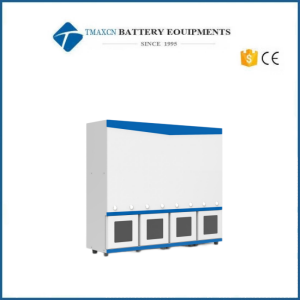 In-Situ Rapid Swelling Screening System Machine For Lithium Battery Silicon-Based Anode R&D
In-Situ Rapid Swelling Screening System Machine For Lithium Battery Silicon-Based Anode R&D
In-Situ Rapid Swelling Screening System MachineFor Lithium Battery Silicon-Based Anode R&D 1. The significance of measuring the expansion behavior of silicon-based anode Due to its unique advantages such as high specific capacity (4200mAh/g) and rich resources, silicon (Si) anode is expected to replace the graphite anode and become the main anode material for the next generation of lithium-ion batteries(LIBs). However, the rapid capacity degradation of silicon materials during the cycling process seriously hinderedits practical applications., This is due to the large volume expansion of silicon anode of more than three times during the intercalation process of lithium-ions, which will destroy the original solid electrolyte interphase (SEI) formed on the surface of the silicon anodes. During the cycling of the LIBs, the SEI will be destroyed and regenerated continually, which consumes a large amount of electrolyte and results in a rapid degradation of the capacity.Therefore, it is urgent to solve the problems caused by the volume expansion of silicon anode. At present, researchers often use composite technology (e.g, "buffer skeleton") to compensate the volume expansion of silicon materials. The common composite routes include silicon-carbon composites, silicon-polymer composites, silicon-based alloy composites, and so on. Silicon-carbon composites are relatively easy and these two elements can also be tightly combined.Because it combines the high stability and conductivity of carbon materials, with the high specific capacity of silic on materials, the silicon-carbon anodes can not only effectively suppresses the volume expansion within a controllable range, but also increase the energy density and cycle life of the LIBs. Thus, it is regard as the most promising silicon-based anode for industrialization, and has received a lot of attentions. It is worth noting that although the composite technology can alleviate the volume expansion of silicon-based anode, it still cannot fundamentally solve the expansion problem. With the increase of silicon content in silicon-based anode, the volume expansion also becomes more significant. Therefore, iit has great significance for the research and manufacturing of silicon-based anodes if the volume expansion behavior of silicon-based anodes can be rapidly evaluated during the charging and discharging. 2. Traditional test methods Traditional method Disadvantage Electron microscopy observation Ex-situ test, high equipment requirements, small observation range, human / material consumption Micrometer/PPG measurement tEx-situest, large human error, poor repeatability, and small measurement range Traditional fixtures Fixed bolt is easy to loosen and deform, resulting in large measurement error and poor repeatability 3. Introduction of in-situ rapid swelling screening for silicon-based anode Product Features 1. In-situ characterization of the expansion thickness change of the silicon based system 2. Four-channel for testing multiple cells simultaneously 3. Suitable for cells with various structures: model coin cell, stacked cell and pouch cell, etc. 4. Visual operation interface, one-click to export the data Software Interface 4. Application 1. In-situ expansion test of model coin cell: Cell parameters:Coin Full coin cell(NCM811 / SiC), with the capacity of about 3 mAh Experimental parameters :Three parallel samples, charing and discharging for three cycles, and synchronously record the expansion thickness of these three full coin cells. Experimental result: The full coin cellexpands / shrinks with the charge / discharge process, and the turning point of the voltage curve in the three cycles is highly consistent with the turning point of the thickness expansion curve, indicating that the expansion thickness curve can effectively reflect the volume change of the electrodes caused by the intercalation / deintercalation of lithium-ions. was only 0.6%, indicating the good cycle consistency of the model coin cell. Note: COV (Coefficient of Variation) = (standard deviation, sigma) / (mean ) 2.In-situ expansion test of multi-layer laminated cells: Cell parameters:Multi-layer stacked cell (NCM811 / SiC), with a capacity of about 400 mAh; Experimental parameters:Three parallel samples, synchronously test the thickness expansion ratioat a constant pressure of 0.1MPa Experimental result: The multilayer stacked cell expands / contracts with the charge / discharge process, and tthe thickness expansion curves of three parallel samples maintain good repeatability for both two cycles.. The maximum expansion ratio is about 12.5%, and the expansion thickness COV of three parallel samples is 1.4%, indicating a good agreement between the parallel samples. 3. In-situ expansion test of the pouch cell: Cell parameters:Multi-layer pouch cell with winding structure (NCM811 / SiC), capacity of about 400 mAh; Experimental parameters: synchronously test thickness expansion ratio at a constant pressure of 0.1MPa. Experimental result: The multilayer pouch cellexpands/contracts with the charging/discharging process, and the thickness expansion curves of three parallel samples maintain good repeatability for both two cycles. When the pouch cell is fully charged, the corresponding maximum expansion ratio is about 4.3%, and the expansion thickness COV between the three groups of batteries is 1.9%, indicating that the consistency among these three parallel samples. 5. Specifications Different model parameters of the RSS series Model RSS1100 RSS1200 RSS1300 TSS1400 Number of channels 4 Pressure control mode By weight By servo motor Pressure range 0.5kg/1kg/5kg (customized according to customer need) 1-100kg Pressure resolution/accuracy ±0.01kg 0.1kg/±0.3%F.S. Thickness range ±5mm Thickness detection resolution/precision 0.1um/±1um 0.1um/±0.1um 0.1um/±1um 0.1um/±0.1um Systematic error ≤3% Max. size of cell 60*94*4mm(customized according to specific needs) Installation requirements Model RSS1100 RSS1200 RSS1300 TSS1400 Power supply 220-240V/50-60Hz Voltage chage tolerance ±10% Power consumption 20W 400W Ambient temperature 25±5C Ambient humidity 80%RH(no moisture condensation)
-
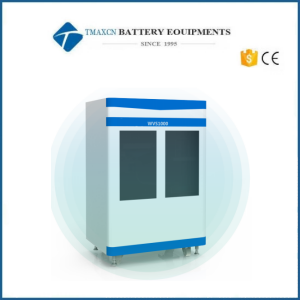 Lab Powder Wet Vibrating Screen Analyzer For Pouch Cell R&D
Lab Powder Wet Vibrating Screen Analyzer For Pouch Cell R&D
Lab Powder Wet Vibrating Screen Analyzer For Pouch Cell R&D Introduction Background: manual screening and mixing method with wooden stick are adopted.. At least two people are required to operate at the same time, and 3-4 people are required when the quantity of incoming materials is large; Problem points: poor operating environment, waste of manpower, low efficiency, introduction of manual methods,and poor consistency. Creative Solutions Advantages 1. Operation automation: realize the automation of powder screening process; 2. Manpower reduction:it can reduce the manpower to only one operator 3. Consistency improvement: it can reduce the differences in personnel skills and improve the consistency level; 4. Efficiency improvement: shorten testing time; 5. Convenient cleaning: all adopt quick-release and quick-change structure; 6. The screening part is of non-metallic structure: it can avoid the interference of metallic particles Equipment parameters Items Parameter Mixing drum 10kg Level sensor tolerance ±3mm Amplitude or speed 0.2-3mm Screenable diameter 1200 mesh, 0.014mm (the screen can be replaced as required) Screening mode Wet sieve Installation requirements Items Parameter Equipment voltage 380V Number of power interfaces 1 Water source interface/number of interfaces Deionized water/2 Size 1000*1000*1500mm
-
 Lab Wet Vibrating Screen System Testing Equipment For Battery Powder R&D
Lab Wet Vibrating Screen System Testing Equipment For Battery Powder R&D
Lab Wet Vibrating Screen System Testing Equipment For Battery Powder R&D Introduction Background: manual screening and mixing method with wooden stick are adopted.. At least two people are required to operate at the same time, and 3-4 people are required when the quantity of incoming materials is large; Problem points: poor operating environment, waste of manpower, low efficiency, introduction of manual methods,and poor consistency. Creative Solutions Advantages 1. Operation automation: realize the automation of powder screening process; 2. Manpower reduction:it can reduce the manpower to only one operator 3. Consistency improvement: it can reduce the differences in personnel skills and improve the consistency level; 4. Efficiency improvement: shorten testing time; 5. Convenient cleaning: all adopt quick-release and quick-change structure; 6. The screening part is of non-metallic structure: it can avoid the interference of metallic particles Equipment parameters Items Parameter Mixing drum 10kg Level sensor tolerance ±3mm Amplitude or speed 0.2-3mm Screenable diameter 1200 mesh, 0.014mm (the screen can be replaced as required) Screening mode Wet sieve Installation requirements Items Parameter Equipment voltage 380V Number of power interfaces 1 Water source interface/number of interfaces Deionized water/2 Size 1000*1000*1500mm
-
 Full Directional Rotation Lab Scale Micron Fine Milling Powder Grinding Ball Mill
Full Directional Rotation Lab Scale Micron Fine Milling Powder Grinding Ball Mill
-
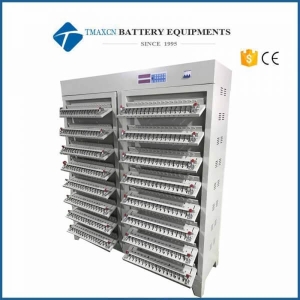 5V6A 512 Channel Li-ion Battery Charging Discharging Tester for Cylinder Cell and Pouch Cell Capacity Testing
5V6A 512 Channel Li-ion Battery Charging Discharging Tester for Cylinder Cell and Pouch Cell Capacity Testing
5V6A 512 Channel Li-ion Battery Charging Discharging Tester for Cylinder Cell and Pouch Cell Capacity Testing
-
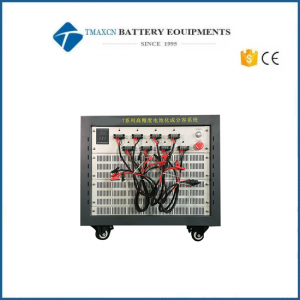 20V 10A 8 Channel Battery Pack Charging and Discharging Machine
20V 10A 8 Channel Battery Pack Charging and Discharging Machine
-
 30V 10A 8 Channel Battery Pack Charging and Discharging Machine
30V 10A 8 Channel Battery Pack Charging and Discharging Machine
-
 60V 10A 8 Channel Battery Pack Charging and Discharging Machine
60V 10A 8 Channel Battery Pack Charging and Discharging Machine
-
 20V 30V 60V 10A 8 Channel Battery Pack Charging and Discharging Machine Aging Cabinet
20V 30V 60V 10A 8 Channel Battery Pack Charging and Discharging Machine Aging Cabinet
-
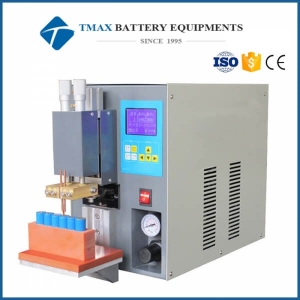 18650 Desk-Top Capacitive Discharge Spot Welding Machine
18650 Desk-Top Capacitive Discharge Spot Welding Machine
It is the most popular capacitive discharge spot welder driven by compressed air. It is designed for the production of the world’s high-class battery manufacturer (NiMH. NiCd, Li-Ion/LiMnNi. LifePO4) with more reliable and consistent welding than AC pulse.
-
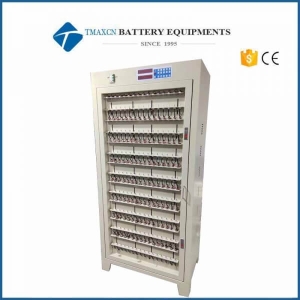 18650 Li Ion Battery Discharge Tester With 256 Channel
18650 Li Ion Battery Discharge Tester With 256 Channel
-
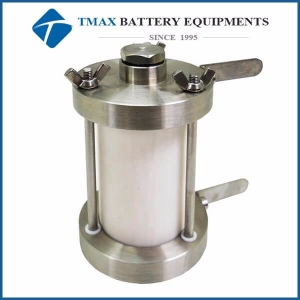 Quartz Split Test Cell for 26650 Cylindrical Cell
Quartz Split Test Cell for 26650 Cylindrical Cell
EQ-SC-26650 Split Type Testing Cell is designed for testing 26650 batteries. Its detachable design allows you to test the cycling behavior as well as structural changes of electrode easily and quickly.
-
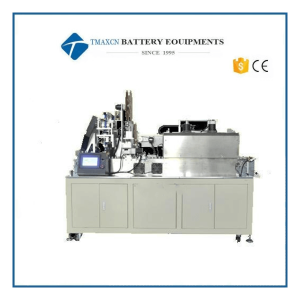 Automatic 32650 PVC Heat Shrink Wrapping Machine For Cylindrical Battery
Automatic 32650 PVC Heat Shrink Wrapping Machine For Cylindrical Battery
Automatic 32650 PVC Heat Shrink Wrapping Machine For Cylindrical Battery FEATURE The cylinder battery laminating machine is a kind of automatic equipment which is used for laminating of cylinder battery, punching and placing insulating gasket and heat shrinkable standard. This equipment can pack about 3300 electric cores per hour, and the structure design is simple and generous, and the performance is stable. In the market, up to now, it is one of the most cost-effective integrated standard equipment Technological process The parameter setting is completed through the touch screen, and the following functions are automatically completed by PLC: manual loading of battery core→ feeding by motor + cylinder → battery delivery by chain → battery core correction + servo labeling → laminating surface pad → correction again → spinning feeding + tunnel furnace heat shrinking → the first turning of air cylinder → loading by belt running → the second turning of air cylinder (feeding groove of finished battery core) → feeding and discharging groove; equipment allocation Sound light alarm is set.Operation parameters can be set according to the actual requirements Structure 1) The structure of the equipment is compact and reasonable, the appearance is beautiful, and the occupied space is small. 2) The equipment is easy to operate, and workers can easily master it without professional training. 3) The equipment is controlled by PLC, which is responsible for battery feeding, labeling, laminating surface pad, heat shrinkable insulation skin, easy to learn, high efficiency, labor cost saving, and good product performance. 4) The equipment and materials are made of high-quality thick cold-rolled sheet metal and aluminum profile frame. 5) The equipment is equipped with universal casters, which makes it easy to move and handle the equipment. SPECIFICATION Power Supply AC 220V±10%/50Hz, Power:≤5KW Working air source 0.5~0.6Mpa Suitable for 32650 etc cylindrical cell Productivity ≥ 55PPM Qualified rate ≥ 98% Weight 600kg Size 2000(L)×900(W)×1700(H)mm
-
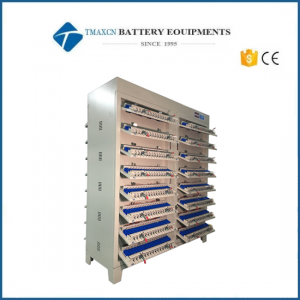 5V5A 18650 Li Ion Battery Discharge Tester With 512 Channel
5V5A 18650 Li Ion Battery Discharge Tester With 512 Channel
-
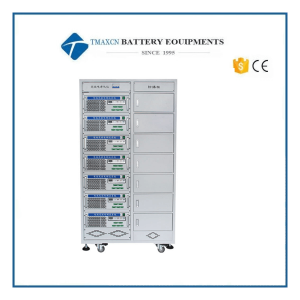 100V 10A 20A Battery Charging&Discharging Testing Equipment&Aging Cabinet
100V 10A 20A Battery Charging&Discharging Testing Equipment&Aging Cabinet
Battery Charging&Discharging Testing Equipment&Aging Cabinet
 ru
ru
 Iris@tmaxcn.com
Iris@tmaxcn.com David@tmaxcn.com
David@tmaxcn.com +86 13174506016
+86 13174506016
